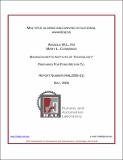| dc.description.abstract | There is increasing interest in actively mitigating safety in vehicles beyond that of
improving crash worthiness. According to the National Highway Transportation Safety
Administration (NHTSA), there are more than 40,000 deaths on highways each year.
This number may be decreasing with increasing active public concern and awareness for
the use of safety restraints, but the numbers are still in excess of 40,000 deaths annually.
Focusing on crash-worthiness as a measure of safety in vehicles will eventually reach a
point of diminishing return, thus there is a need for automotive manufacturers to shift
their safety focus to crash avoidance safety systems (Runge, 2002).
In the public domain, significant progress and advancements have been made under the
Intelligent Vehicles Initiative (IVI) set up by U.S. Department of Transportation to
prevent motor vehicle crashes by assisting drivers in avoiding hazardous mistakes (U.S
DOT, 1998). One IVI focus area is facilitating the rapid deployment of Collision
Avoidance Systems (CAS) in vehicles. Collision Avoidance Systems are a subset of
Advanced Vehicle Control Safety Systems (AVCSS) which come under the umbrella of
Intelligent Transportation Systems (ITS). These Collision Avoidance Systems warn
drivers of imminent collisions and can potentially help to save lives. Primary directions
of research in CAS are determining implementation strategies and technologies in
vehicles and roadway infrastructure, as well as optimizing the driving performance of
different populations of drivers when using CAS.
In CAS implementation, vehicles will communicate with other vehicles as well as with
the roadway infrastructure via sensors and telecommunication networks. The data
obtained can then be used in Collision Avoidance Systems. Vehicle-to-vehicle CAS
include warnings that trigger when a vehicle is about to collide with another vehicle.
Examples include Frontal Warning, Rear Warning and Blind Spot Detection Warnings.
Vehicle-to-infrastructure CAS include warnings that trigger when a vehicle is about to
have a collision with the roadway infrastructure. Examples include Intersection Warnings,
Lane Departure Warnings, Curve Speed Warnings and Road-condition Warnings.
Driving in a dynamic environment has become increasingly complex, such that drivers
must visually track objects, monitor a constantly changing system, manage system
information, to include the explosion of telematics, and make decisions in this dynamic
and potentially high mental workload environment. Introducing Collision Avoidance
Systems into vehicles could add to the complexity of this dynamic environment as
different drivers will respond differently to Collision Avoidance Systems and there are
many critical human factors issues that require investigation. | en |
